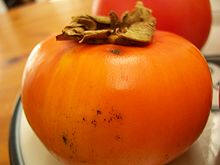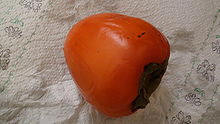2024 Far Western North Carolina Persimmon U-Pick Farms and Orchards - PickYourOwn.org
Find a pick-your-own farm near you! Then learn to can and freeze! Since 2002! We update continuously; Beware the copycat websites!
Search pickyourown.org

Persimmon U-Pick Orchards in Far Western North Carolina in 2024, by county
Below are the U-Pick orchards and farms for persimmons that we know of in this area.
Not all areas of a state have persimmons orchards that are open to the public. If you know of any others, please tell us using the add a farm form!
Remember to always check with the farm's own website or Facebook page before you go - or call or email them if they don't have a website or Facebook page. Conditions at the farms and crops can change literally overnight, so if you want to avoid a wasted trip out there - check with the farm directly before you go! If I cannot reach them, I DON'T GO!
PLEASE report closed farms, broken links and incorrect info using the "Report Corrections" form below.
Search pickyourown.org
Graham County
- Stoney Hollow Farm
- Uses natural growing practices, apples, blackberries, blueberries, cherries, corn (sweet), flowers, grapes, melons, other berries, pears, peaches, peppers, persimmons, plums, pumpkins, raspberries, summer squash, winter squash, tomatoes, other vegetables, prepicked produce, farm market, gift shop, restrooms
941 Ollies Creek Road, Robbinsville, NC 28771. Phone: 828-735-2983. Email: stoneyhollowfarm@outlook.com . Open: 5 days a week, 8 am to 6 pm; Closed Wednesdays and Saturdays. Directions: From the center of Robbinsville \(Hwy. 129Hwy. 143\) go North on highway 129 3 miles. Just before the Ted Jordan Bridge, turn right on E. Buffalo Circle. Go 1 mile and turn right on E. Buffalo Road Go .3 mile and turn left on Ollies Creek Road Go .9 mile and you will see the farm on the left. Parking, farm map, and picking buckets are available in the barn at the top of the hill. . Click here for a map and directions . Payment: Cash, Check.
Stoney Hollow Farm Facebook page . From the center of Robbinsville (Hwy. 129/Hwy. 143) go North on highway 129 3 miles. Just before the Ted Jordan Bridge, turn right on E. Buffalo Circle. Go 1 mile and turn right on E. Buffalo Road Go .3 mile and turn left on Ollies Creek Road Go .9 mile and you will see the farm on the left. Parking, farm map, and picking buckets are available in the barn at the top of the hillCrops are usually available in April through NovemberJams and baked goods featuring products from the farm are available. Be sure to visit our website and sign up to receive a free e-letter with updates during the peak season. We use natural practices, but are not certified Organic. (UPDATED: July 25, 2023, JBS)
Persimmons

Persimmon Picking Tips, Recipes and Information
Persimmons, are a VERY tart and rare fruit. More popular in Asia, the Asian varieties have been introduced to North America and become popular. Native North American Fuyu persimmons (shown at top right) are flattened in shape.
The Asia hachiya persimmons are more elongated and a bit sweeter. All persimmons are exceedingly tart until the are dead-ripe and slight mushy in texture.
Uses:
Persimmons are typically made into jelly, but also used for their flavor in baked goods such as muffins, tarts and sauces. Persimmon berries also freeze well.

If you're looking for great, easy to follow recipes to make jelly, see these pages:
Harvesting Season:
The exact timing of Persimmon harvest can vary depending on your location and climate, but it generally occurs in the summer months. In most regions, you can expect to start harvesting Persimmons from late July to early August.
Persimmons are an unusual fruit because they actually DO ripen after being harvested. In fact, it is BEST to pick the persimmons while they are hard, and allow them to ripen and soften in a cool basement. This avoid bug and bird danage.
Determining Ripeness:
Ripe Persimmons are soft, almost mushy, and have a bright orange color.
How to pick or harvest:
To harvest Persimmons, simply hold the branch beneath and gently pluck them off with your fingers. It's best to place a container or basket beneath the branch to catch them if they fall.
Handling and Storage:
After harvesting, sort through the fruit and remove any damaged or overripe ones. Store them in a shallow container, preferably in a single layer, to prevent crushing and allow for proper airflow. Refrigerate them when they become ripe and soft; consume them within a few days for optimal freshness. If you have an abundant harvest, consider freezing them for longer-term storage.
Other Local Farm Products (Honey, Horses, Milk, Meat, Eggs, Etc.)
(NOT pick-your-own, unless they are also listed above)
- Farm markets and roadside stands
- Local Honey Finder
- Local Meat, Milk and Eggs
- Venues: Farms, Wineries, Orchards for your event, wedding or party
- Easter egg hunts
- Children"s consignment sales
- Fruit and vegetable festivals
- Winery tours and wine tastings
- Horse rides, stables, lessons, trails
- Maple Syrup farms and sugarworks
- Bed & Breakfasts on Farms, Wineries, Ranches and Orchards
- Pumpkin patches
- Corn mazes
- Zombie Paintball venues
- Christmas Tree Farms & lots
- Environmental resources
- Consumer fraud information
- Wholesale food sources
- Resources for Farmers
Looking for canning equipment and supplies?
Water bath canner with a jar rack
Pressure canners for gas, electric and induction stoves : Presto 23Qt or T-fal 22Qt
Canning scoop (this one is PERFECT)
Ball Blue book (most recent version)
Find Other types of farms:
Farm markets and roadside stands
Road trips and camping resources
Local Honey , apiaries, beekeepers
Consumer fraud and scams information
Home canning supplies at the best prices on the internet!
Maple Syrup Farms , sugarworks, maple syrup festivals
Environmental information and resources
Farms For Your Event for birthday parties, weddings, receptions, business meetings, retreats, etc.
Festivals - local fruit and vegetable festivals
Get the
most recent version of
the Ball Blue Book
With this Presto 23 quart pressure canner and pressure cooker, you can "can" everything, fruits, vegetables, jams, jellies, salsa, applesauce, pickles, even meats, soups, stews. Model 01781

You can make jams, jellies, can fruit, applesauce, salsa and pickles with water bath canners, like this Granite Ware 12-Piece Canner Kit, Jar Rack, Blancher, Colander and 5 piece Canning Tool Set

This page was updated on
Disclosure: As an Amazon Associate I earn from qualifying purchases.
Want to make a donation? pickyourown.org does not charge either farmers or consumers! I do all of the programming, web design and updates myself. If you'd like to make a donation to help me pay to keep the website going, please make a donation to me at Benivia through our secure donation processor. Just click the button below and follow the instructions:
All images and text
© Copyright Benivia, LLC 2008-2019 Disclaimer
and Privacy Policy
.
Permission is given to link to any page on www.pickyourown.org
but NOT to copy content and republish it. Those copying content from this website and publishing it will be vigorously legally prosecuted.
Sitemap
Local Weather Forecast (Scroll down)
Click the image below for a complete weather forecast.


